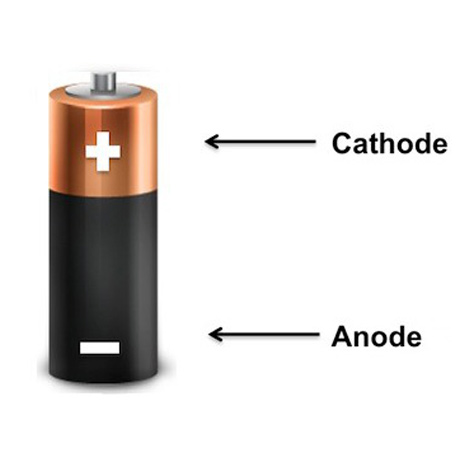Electrode
BASIC FACTS ABOUT ELECTRODE :
An electrode is a solid electric conductor that carries electric current into non-metallic solids, or liquids, or gases, or plasmas, or vacuums. Electrodes are typically good electric conductors, but they need not be metals. Electrodes are commonly used in electrochemical cells, semiconductors like diodes and in medical devices.
The main use of electrodes is to generate electrical current and pass it through non-metal objects to basically alter them in several ways. Electrodes are also used to measure conductivity. In an electrochemical cell, reduction and oxidation reactions take place at the electrodes.
An electrode is classified as either a cathode or an anode depending on if current is flowing into or out of the electrode. Conventional current flows into a device through its anode and leaves the device through the cathode. The electrode at which reduction takes places is called the cathode. Oxidation takes place at the anode.
Whether an electrode operates as a cathode or anode depends on the direction the cell is operating. If a cell is switched from operating galvanically (i.e. outputting energy like a battery) to electrolysis (energy is input to the cell) then its cathode will become its anode and vice versa. Electrodes are vital components of electrochemical cells. They transport produced electrons from one half-cell to another, which produce an electrical charge. This charge is based off a standard electrode system (SHE) with a reference potential of 0 volts and serves as a medium for any cell potential calculation.
In voltaic and electrolytic cells, the cathode is the electrode at which reduction occurs, while oxidation occurs at the anode. This way of defining cathodes and anodes is more widely used in chemistry. Any anions or cations in the cell will also be attracted to the anode and cathode respectively. Electrical energy can be used to convert salts and ores to metals.In the Hall-Heroult process to extract aluminium metal from aluminium oxide the anode and cathode are both made of graphite.
Sodium metal is produced by electrolysis using a carbon anode and an iron cathode. Examples of typical materials used for electrodes in analytical chemistry are amorphous carbon, gold, and platinum. Glass electrodes are often used in pH measurements; in this application the glass is chemically doped to be selective to hydrogen ions.
Batteries contain a variety of electrodes, depending on the battery type.
- Lead-acid batteries are based on lead electrodes.
- Zinc-carbon batteries are made with zinc and amorphous carbon electrodes.
- Lithium polymer batteries have electrodes made of a solid polymer matrix within which lithium ions can move and act as charge carriers.
A secondary cell, for example a rechargeable battery, is a cell in which the chemical reactions are reversible. When the cell is being charged, the anode becomes the positive (+) and the cathode the negative (−) electrode. This is also the case in an electrolytic cell. When the cell is being discharged, it behaves like a primary cell, with the anode as the negative and the cathode as the positive electrode. Charging and discharging processes, such as those in Lithium-ion batteries, tend to incur large losses through contact resistance at electrodes. Minimising these electrode localised losses constitutes an important approach in improving energy usage in electrochemical storage.
Electrode refers to a conductor by which electrical currents can travel. In fact, these are sometimes are referred to as electrical conductors. You can find them in a wide variety of polarized electrical components such as batteries, electrolytic cells, or electron tubes, cells, diodes, and fuel cells.
Some commonly used inert electrodes: graphite(carbon), platinum, gold, and rhodium.Some commonly used reactive (or involved) electrodes: copper, zinc, lead, and silver.
In a vacuum tube or a semiconductor having polarity (diodes, electrolytic capacitors) the anode is the positive (+) electrode and the cathode the negative (−). The electrons enter the device through the cathode and exit the device through the anode. Many devices have other electrodes to control operation, e.g., base, gate, control grid.
In a three-electrode cell, a counter electrode, also called an auxiliary electrode, is used only to make a connection to the electrolyte so that a current can be applied to the working electrode. The counter electrode is usually made of an inert material, such as a noble metal or graphite, to keep it from dissolving.
Uses of an Electrode :
- Electrodes for fuel cells.
- Electrodes for medical purposes, such as EEG (for recording brain activity), ECG (recording heart beats), ECT (electrical brain stimulation), defibrillator (recording and delivering cardiac stimulation).
- Electrodes for electrophysiology techniques in biomedical research.
- Electrodes for execution by the electric chair.
- Electrodes for electroplating.
- Electrodes for arc welding.
- Electrodes for cathodic protection.
- Electrodes for grounding.
- Electrodes for chemical analysis using electrochemical methods.
- Nano electrodes for high-precision measurements in Nano electrochemistry.
- Inert electrodes for electrolysis (made of platinum).
- Membrane electrode assembly.
- Electrodes for Taser electroshock weapon.
